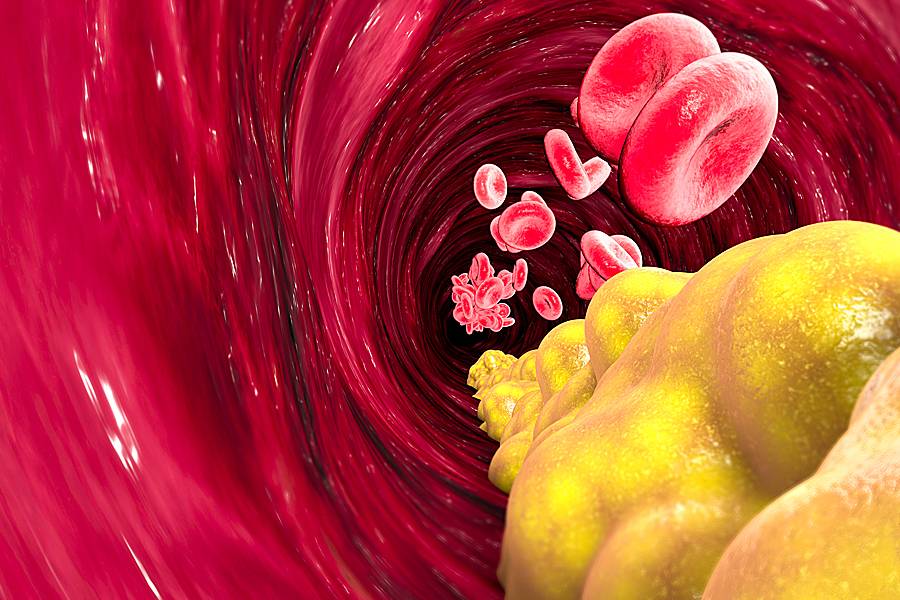This content is provided to Johns Hopkins employees through a partnership with EHP.
If your cholesterol levels aren't where they should be, you can control them through diet, exercise, weight management, quitting smoking, stress management, and taking your medicines correctly. These actions also can lower your risk for cardiovascular disease.
Eating healthy
Your health care provider will give you information on diet changes you may need to make and may recommend that you see a registered dietitian for help. Changes may include:
- Cutting back on the amount of fat and cholesterol in your meals
- Eating less salt (sodium), which is especially important if you also have high blood pressure.
- Eating more fresh vegetables and fruits
- Eating lean proteins such as fish, poultry, beans, and peas
- Eating less red meat and processed meats
- Using low-fat dairy products
- Using vegetable and nut oils in limited amounts
- Limiting how many sweets and processed foods such as chips, cookies, and baked goods you eat
- Limiting how many sugar-sweetened beverages you drink
- Limiting how often you eat out
- Limiting alcohol
Getting exercise
Regular exercise is a good way to help your body control cholesterol. It can:
- Raise your good cholesterol
- Help lower your bad cholesterol
- Let blood flow better through your body
- Give more oxygen to your muscles and tissues
- Help you manage your weight
- Help your heart pump better
- Lower your blood pressure
Your health care provider may recommend that you get moderate to vigorous physical activity for at least 40 minutes each day, at least three or four days each week. A few examples of moderate to vigorous activity are:
- Walking at a brisk pace (about 3 to 4 miles per hour)
- Jogging or running
- Swimming or water aerobics
- Hiking
- Dancing
- Martial arts
- Tennis
- Riding a bicycle or stationary bike
- Dancing
Managing your weight
If you're overweight or obese, your health care provider will work with you to help you lose weight and lower your body mass index, or BMI. Making diet changes and getting more physical activity can help. Changing your diet will help you lose weight more easily than adding exercise.
Quitting smoking
Smoking and other tobacco use can raise cholesterol and make it harder to control. Quitting is tough, but millions of people have given up tobacco for good.
Do any of these effects from smoking make you think twice about your habit?
- Keeps your cholesterol high, even if you make all the other changes you're supposed to
- Damages your body, especially harming your heart, lungs, skin, and blood vessels
- Makes you more likely to have a heart attack, stroke, or cancer
- Stains your teeth
- Makes your skin, clothes, and breath smell bad
- Costs a lot of money
Ask your health care provider for medicines or nicotine replacement products to help you quit.
Controlling stress
Learning ways to control stress will help you deal with it in your home and work life and can greatly lower your risk of getting cardiovascular disease.
Making the most of medicines
Healthy eating and exercise are a good start to keeping your cholesterol down, but you may need some extra help. If your doctor prescribes medicine, be sure to take it exactly as directed.
- Remember to tell your health care provider about all other medicines you take, including vitamins and herbs.
- If after starting to take a medicine, you have side effects such as muscle aches, weakness, blurred vision, rust-colored urine, yellowing of eyes or skin (jaundice), abdominal pain, or headache, tell your health care provider.
- Don't skip a dose or stop taking your medicine because you feel better or because your cholesterol numbers go down. Never stop taking your medicine unless your health care provider has told you it's OK.
- If you have any questions about your medicines, ask your health care provider.
Risk groups
In order to control their cholesterol, some people may need to take medicines called statins in addition to eating a healthy diet and getting regular exercise. Statins can help you stay healthy and can also help prevent a heart attack or stroke.
You may need to take a statin if you are in one of the intermediate, high, or very high risk groups or if you have multiple risk conditions. Calculating a score is done by looking at certain risk factors that indicate an increased risk for atherosclerosis. The risk calculator tool looks at:
- Ages between 40 and 79 years
- Gender
- Race
- Blood pressure (systolic and diastolic measurements)
- Total cholesterol, good cholesterol (HDL), and bad cholesterol (LDL) levels
- History of diabetes
- Current or past smoking history
- Treatment for high blood pressure
- Treatment of cholesterol with a statin
- Current use of aspirin
If you are uncertain about your risk factors, you and your provider may decide to proceed with a scan to determine a coronary artery calcium score. Depending on the results of this scan, you and your provider may decide whether starting a medicine for cholesterol is the best treatment option for you.
Talk with your health care provider about your treatment goals. Make sure you understand why these goals are important, based on your own health history and your family history of heart disease or high cholesterol.
You may need to take more than one medicine to reach the cholesterol goals that you and your provider decide on. Ask your provider about any side effects your medicines may cause.
And make a plan to have regular cholesterol checks.
Posted in Health+Well-Being
Tagged hr newswire








